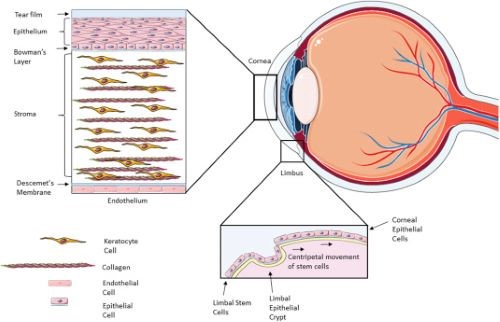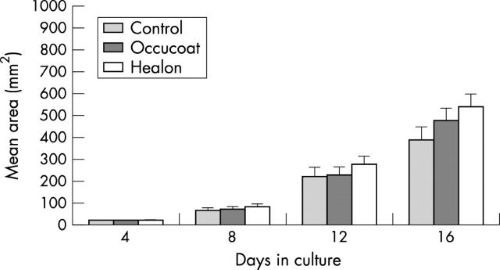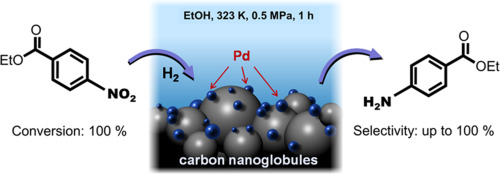Sodium Hyaluronate Promotes the Migration of Human Corneal Epithelial Cells in Vitro
Background
Sodium hyaluronate, also known as hyaluronic acid (HA), is a naturally occurring glycosaminoglycan that is found in the extracellular matrix of many tissues, including the cornea. HA has been widely used in ophthalmology for its lubricating and protective properties. In recent years, there has been growing interest in the potential role of HA in promoting corneal wound healing. In this article, we will discuss the findings of a study that investigated the effect of sodium hyaluronate on the migration of human corneal epithelial cells in vitro.

[1]
Figure 1. Corneal Epithelium
Methods
This study is published in the Journal of Ophthalmology, and it evaluated the effect of different concentrations of sodium hyaluronate on the migration of human corneal epithelium with the following methods.
- Materials: The researchers employed a monolayer of corneal epithelial cells, which were obtained from 32 donors of different ages. A scratch was made on such corneal epithelium, and the cell migration process was monitored over time.
- Cultures: All the human corneal epithelial cells were set on three culture conditions: (1) just culture medium, (2) hydroxypropylmethylcellulose enriched medium, and (3) sodium hyaluronate enriched medium. [2]
- Measurements: The migrating epithelial cells in each case were measured on days 4, 8, 12, and 16.
Results
- The results of the study showed that the migration of corneal epithelial cells was significantly increased in the presence of sodium hyaluronate.
- The effect was dose-dependent, with higher concentrations of sodium hyaluronate leading to greater cell migration.
- The researchers also found that the effect of sodium hyaluronate was time-dependent, with the maximum effect observed 24 hours after treatment.
The bar chart below shows the cell migration areas in the different culture conditions in detail. Note: standard medium (control), hydroxypropyl methylcellulose (Occucoat), and sodium hyaluronate (Healon). [2]

Figure 2. Mean Area of Migrating Human Corneal Epithelial Cell Sheets in the Different Culture Conditions
Discussions
The mechanism of action for the effect of sodium hyaluronate on corneal epithelial cell migration is not fully understood. Nevertheless, several theories have been proposed.
One theory is that sodium hyaluronate provides a physical scaffold that supports cell migration. HA molecules are large and complex, and they can create a network of fibers that provide a substrate for cell migration.
Another theory is that sodium hyaluronate stimulates the production of growth factors and cytokines that promote cell migration. HA has been shown to bind to cell surface receptors and activates signaling pathways that lead to the production of growth factors, such as epidermal growth factor (EGF) and fibroblast growth factor (FGF), that are known to stimulate cell migration.
Applications
The findings of this study have important implications for the use of sodium hyaluronate in ophthalmology.
Corneal epithelial cell migration is a critical step in the process of corneal wound healing. Injuries to the cornea, such as those caused by contact lens wear, trauma, or surgery, can lead to epithelial defects that can impair vision and increase the risk of infection. The promotion of corneal epithelial cell migration by sodium hyaluronate may accelerate the healing process and reduce the risk of complications.
In addition to its role in corneal wound healing, sodium hyaluronate has been shown to have other therapeutic applications in ophthalmology. For one thing, it is used as a lubricant and protective agent in the treatment of dry eye syndrome. You can use medical-grade sodium hyaluronate to save yourself from redness, itchy eyes, blurred vision, and other symptoms of dry eye syndromes. For another, it serves as a viscoelastic agent in cataract surgery and other intraocular procedures. Sodium hyaluronate is a popular ophthalmic viscoelastic device (OVD) used in cataract surgery. It also acts as an OVD in corneal transplant and retina attachment surgery.
Related reading: Which Eye Surgeries Get Use of Hyaluronic Acid Preparations?
Conclusion
In a word, the findings of this study suggest that sodium hyaluronate enhances the migration of human corneal epithelial cells in vitro. The mechanism of action for this effect is not fully understood, but it may involve the physical scaffold provided by HA molecules and the activation of growth factor signaling pathways. These findings have important implications for the use of sodium hyaluronate in ophthalmology, particularly in the treatment of corneal injuries and the promotion of corneal wound healing. Further research is needed to fully understand the mechanism of action for the effect of sodium hyaluronate on corneal epithelial cell migration and to optimize its use in the clinical setting.
Stanford Advanced Materials (SAM) is a trustful supplier of a variety of sodium hyaluronate. There are hyaluronic acids of medical grade, cosmetic grade, and food grade on our website. High molecular weight, middle molecular weight, and low molecular weight sodium hyaluronates are also available. Send us an inquiry if you are interested.
Reference:
[1] Sophia Masterton, Mark Ahearne, Mechanobiology of the corneal epithelium, Experimental Eye Research, Volume 177, 2018, https://www.sciencedirect.com/science/article/pii/S0014483518302082
[2] Gomes JA, Amankwah R, Powell-Richards A, Dua HS. Sodium hyaluronate (hyaluronic acid) promotes migration of human corneal epithelial cells in vitro. Br J Ophthalmol. 2004 Jun;88(6):821-5. doi: 10.1136/bjo.2003.027573. PMID: 15148219; PMCID: PMC1772195.



